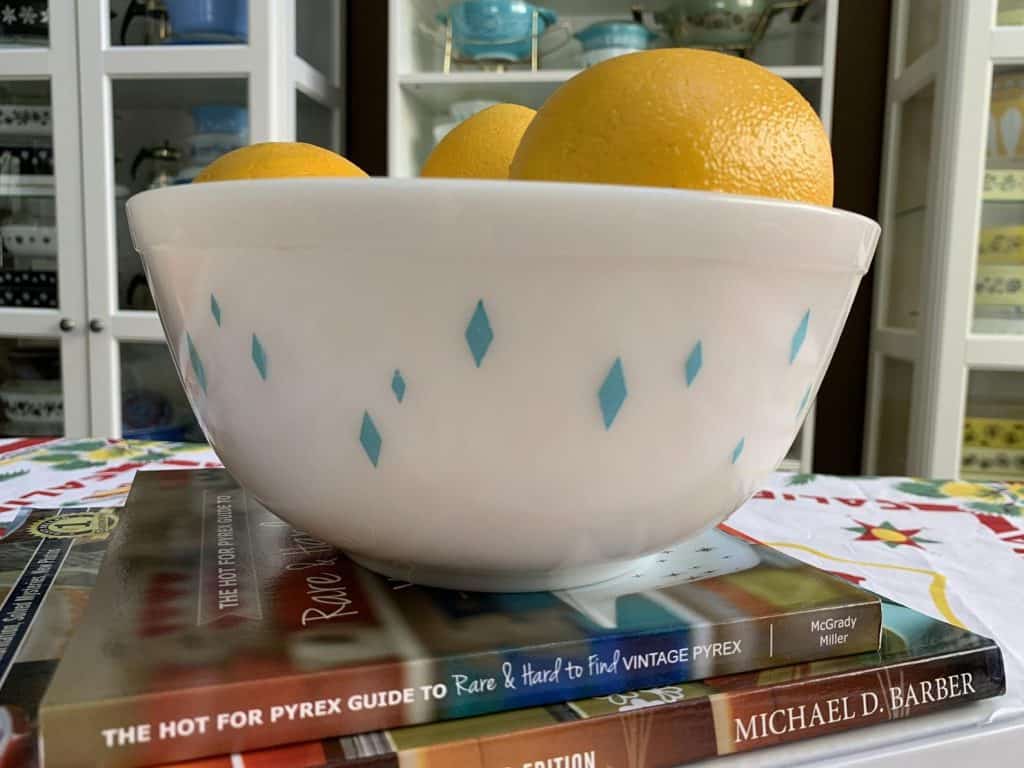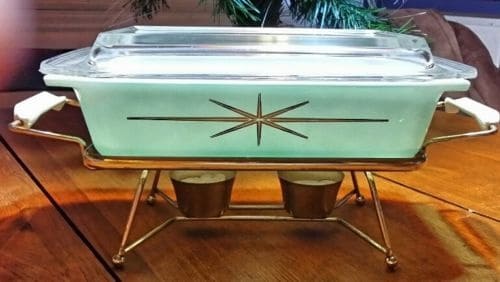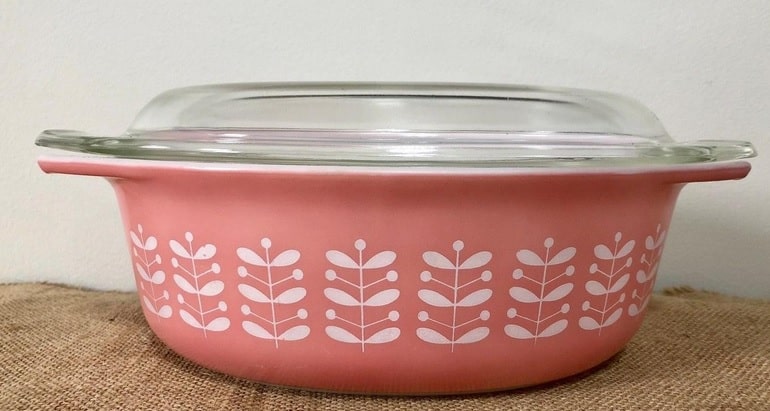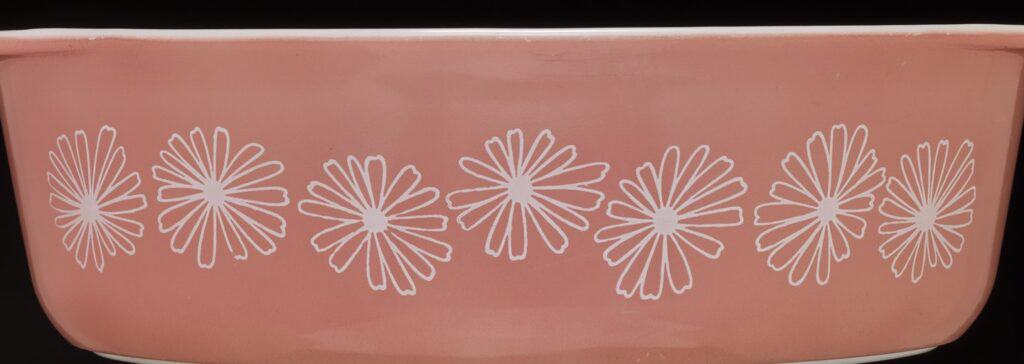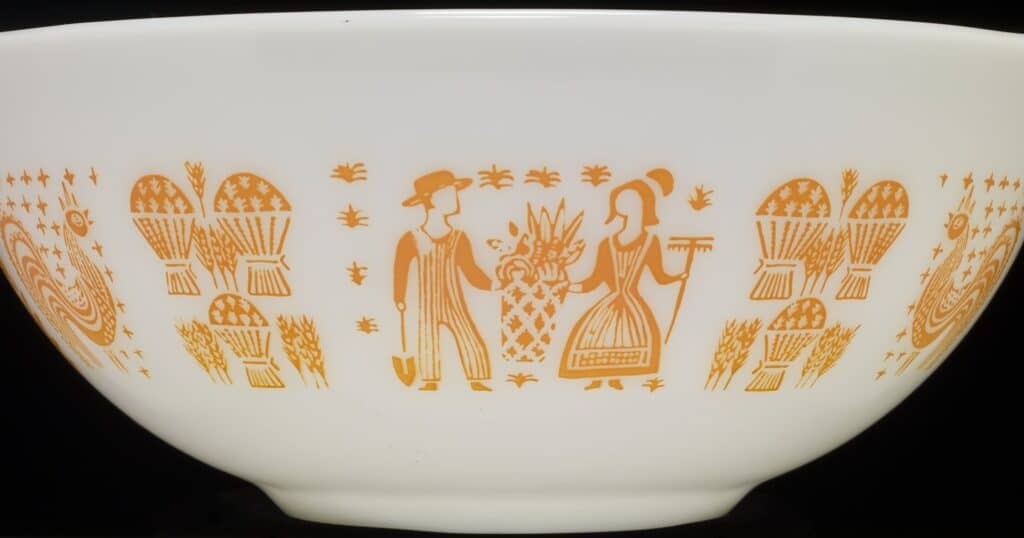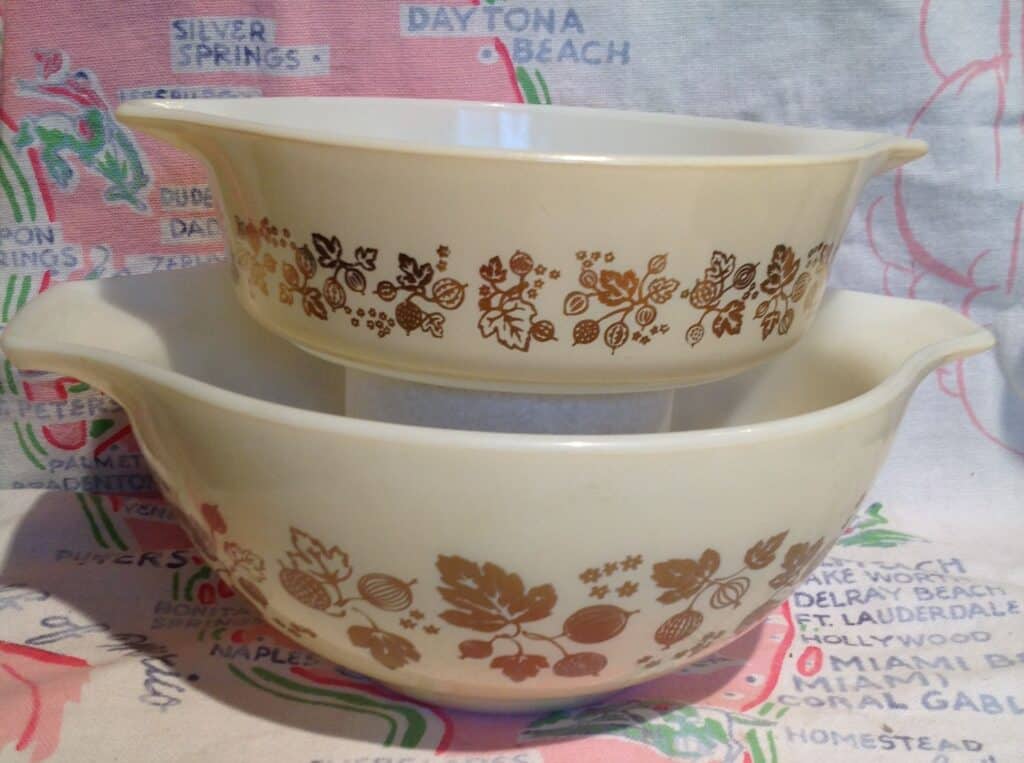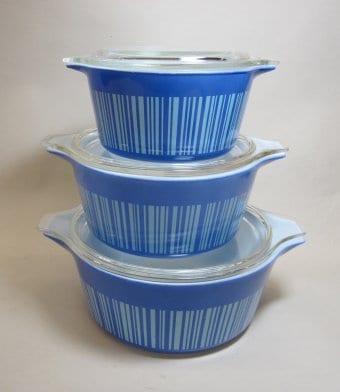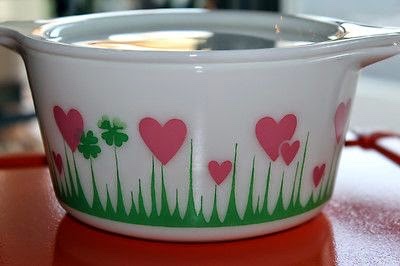Pyrex, which was originally made of low-thermal-expansion borosilicate glass, was first introduced in 1915 by Corning Glass Works. Beginning in the late 1930s and 1940s, Pyrex began offering a number of kitchenware products, especially casserole and serving dishes. In the 1950s, Pyrex started adding fun patterns to its kitchenware items and they exploded in popularity. Some of these items were limited edition promotional pieces, while others were employee gifts. These Pyrex patterns have become rare and are sought after by vintage Pyrex collectors.
As of June 2021, the information on this list is as accurate as possible and will be updated as needed. With the exception of the rarest Pyrex pattern, the rest of this list is arranged in alphabetical order.
- Turquoise Diamonds
- Starburst (Cinderella Serving Casserole)
- Pink Stems
- Pink Daisy
- Orange Butterprint
- Golden Gooseberry
- Eyes
- Barcode
- Balloons
- Lucky in Love
Year(s) Produced: Late 1950s
Featured On: Mixing bowl (No. 403)
Current Price: None currently listed on resale sites, but typically sells for hundreds of dollars

photo source: estatesales.org
Until 2018, the Pyrex pattern dubbed Turquoise Diamonds was pretty much a mystery. However, one Pyrex collector discovered a complete Turquoise Diamonds bowl with its original box. It turns out that the Turquoise Diamonds bowl was made for a brand called Dainty Maid, which is why the piece bears no Pyrex markings. Dainty Maid sold housewares and glass products between 1949 to 1960. Pyrex experts believe the Turquoise Diamonds bowl was produced sometime in the late 1950s.
Did you know?
The Turquoise Diamonds Dainty Maid serving bowl came with a cradle and glass lid that had a metal handle that matched the cradle.
Year(s) Produced: 1960
Featured On: Space saver casserole dish (No. 575)
Current Price: None currently listed on resale sites

photo source: Collectors Weekly
Starburst, which is officially known as the Cinderella Serving Casserole, was a promotional item from 1960. This rare pattern came on a turquoise two-quart Square Space Saver, that came with a cradle and double-candle warmer. Starburst is one of the most wanted rare Pyrex patterns, but the the Cinderella Serving Casserole almost never turns up for sale.
Did you know?
The Starburst pattern was only used one other time, on a black Space Saver Casserole with a gold design. The release date of that dish is unknown and it may be even rarer than the turquoise Cinderella Serving Casserole.
Year(s) Produced: 1962
Featured On: Small oval casserole dish (No. 043)
Current Price: None currently listed on resale sites

photo source: Worth Point
Pink Stems is yet another rare Pyrex pattern that has an unknown provenance. There is very little information about Pink Stems and no one even knows if the pattern has an official name. Every Pink Stems piece that has come up for sale is a small oval casserole dish with clear glass lid. It’s believed that the Pink Stems casserole dish was a limited promotional item from the early 1960s.
Year(s) Produced: 1956 to 1962
Featured On: Oval casseroles; divided dishes; open bakers; and space savers
Current Price: $45 to $190

photo source: Corning Museum of Glass
Did You Know?
Although Pyrex had released solid colored dishes with patterns for years, Pink Daisy (along with Snowflake) were the first patterned opalware to be released using a new screen-printing process.
Year(s) Produced: 1957 to 1968
Featured On: Cinderella nesting bowls
Current Price: $175 to $300 on various resale sites

photo source: Corning Museum of Glass
Butterprint aka “Amish” print was one of the first patterns released on Pyrex opalware in 1957. While Butterprint was popular until it was discontinued in 1968, some colors, in particular Orange Butterprint, are very rare. Orange Butterprint appears on Cinderella nesting bowls, which were a promotional item. The only way to get the Orange Butterprint nesting bowls was through S&H Green Stamps, which was a popular line of trading stamps that could be redeemed for items from the S&H catalog from the 1930s to late 1980s. Since Orange Butterprint bowls rarely come up for sale, there must not have been many people who redeemed their S&H stamps for them.
Year(s) Produced: 1957 – 1966
Featured On: Cinderella mixing bowls (No. 440); various casserole dishes
Current Price: None currently for sale, but average past price few hundred dollars

photo source: Pinterest
Gosseberry was one of the first patterns released for Pyrex’s opalware line in 1957. The print was produced until 1966 and over that time period, many different colorways were released. While most Gooseberry dishes came in pink pattern on white background or vice versa, black on yellow was pretty rare. However, the rarest Gooseberry pattern is Golden Gooseberry on beige background. The Golden Gooseberry pieces could have been promotional items, test items, or even employee appreciation gifts.
Did You Know?
The Black on Yellow/White Gooseberry pattern was only available on the four-piece Cinderella bowl set and was discontinued in 1962.
Year(s) Produced: c.1950 to 1959
Featured On: Chip and Dip Set
Current Price: $450 to $1,125 on various resale sites

photo source: eBay
Officially released as the “Hot ‘N’ Cold” Chip and Dip Set, the pattern affectionately called “Eyes” is another elusive and mysterious vintage Pyrex pattern. No one knows when Eyes was released, but based on the make of the bowls and the pattern, Pyrex experts have dated the pattern to around the 1950s. Additionally, no one is sure if the Hot ‘N’ Cold Chip and Dip Set was a promotional item or if it was made for a third party company.
Some pieces with the Eyes pattern don’t have the traditional Pyrex mark on the bottom of the bowls. The mystery surrounding the Eyes pattern seems to have increased the pattern’s desirability and sellers are asking for hundreds, even a few thousand dollars for pieces.
Did You Know?
According to the Corning Museum of Glass, the Eyes pattern also appeared on a coffee carafe and a clear one-quart juicer with a turquoise plastic lid.
Year(s) Produced: 1966
Featured On: Three-piece Bake, Serve and Store Set (No. 470); Three-piece Cinderella Casserole Set (No. 480); other various round casserole dishes
Current Price: $75 for No. 472 Casserole Dish

photo source: Corning Museum of Glass
The pattern known as “Barcode” in the Pyrex community was only available in 1966 on dishes that were promotional items or test pieces. While all Barcode pattern Pyrex is rare, the most common of the group is the blue colorway, which is officially called Blue Stripe. Blue Barcode pieces do come up from time to time and can go for around $100 or so. In addition to the Blue Barcode design, there were prototypes made in yellow and orange, brown and orange, yellow and black, blue and yellow, green and white, and black and blue.
Did You Know?
Typically promotional items from the time period that Blue Barcode was released came as single items, but Blue Barcode was available in two different casserole sets.
Year(s) Produced: 1958
Featured On: Cinderella Chip and Dip Set
Current Price: $250 to $490 on various resale sites

photo source: eBay
Did You Know?
The Balloons Chip and Dip set retailed for $3.95 and was the first patterned Pyrex promotional item that came as a Chip and Dip set.
Year(s) Produced: 1959
Featured On: One-quart round casserole dish (No. 473)
Current Price: None currently listed on resale sites, but a piece sold for over $4,000 in 2015

photo source: erinmiddlebrooks.com
Evidence that Lucky in Love may have been a test piece is that the Corning Museum of Glass has a Lucky in Love piece without hearts, while the piece that had everyone buzzing in 2015 had hearts. The hearts on the Lucky in Love piece, which sold for over $4,000, have minor printing errors that show the green clovers and blades of grass coming through. This would not have been up to Corning’s standards, so these few surviving test pieces may have been taken home by employees.
While vintage Lucky in Love Pyrex pieces are pretty impossible to find, the pattern became so popular after that 2015 eBay sale, that Pyrex re-released the pattern onto its modern glass pieces.
Did You Know?
The lid that came with the vintage Lucky in Love casserole dish was opal, which was very unusual for the time period, as Pyrex lids were almost exclusively glass until the early 1970s.

